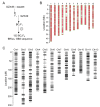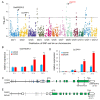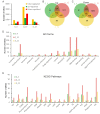Combination of Genomics, Transcriptomics Identifies Candidate Loci Related to Cold Tolerance in Dongxiang Wild Rice
- PMID: 36145730
- PMCID: PMC9506393
- DOI: 10.3390/plants11182329
Combination of Genomics, Transcriptomics Identifies Candidate Loci Related to Cold Tolerance in Dongxiang Wild Rice
Abstract
Rice, a cold-sensitive crop, is a staple food for more than 50% of the world's population. Low temperature severely compromises the growth of rice and challenges China's food safety. Dongxiang wild rice (DXWR) is the most northerly common wild rice in China and has strong cold tolerance, but the genetic basis of its cold tolerance is still unclear. Here, we report quantitative trait loci (QTLs) analysis for seedling cold tolerance (SCT) using a high-density single nucleotide polymorphism linkage map in the backcross recombinant inbred lines that were derived from a cross of DXWR, and an indica cultivar, GZX49. A total of 10 putative QTLs were identified for SCT under 4 °C cold treatment, each explaining 2.0-6.8% of the phenotypic variation in this population. Furthermore, transcriptome sequencing of DXWR seedlings before and after cold treatment was performed, and 898 and 3413 differentially expressed genes (DEGs) relative to 0 h in cold-tolerant for 4 h and 12 h were identified, respectively. Gene ontology and Kyoto encyclopedia of genes and genomes (KEGG) analysis were performed on these DEGs. Using transcriptome data and genetic linkage analysis, combined with qRT-PCR, sequence comparison, and bioinformatics, LOC_Os08g04840 was putatively identified as a candidate gene for the major effect locus qSCT8. These findings provided insights into the genetic basis of SCT for the improvement of cold stress potential in rice breeding programs.
Keywords: Dongxiang wild rice; differentially expressed genes; quantitative trait locus; seedling cold tolerance; transcriptomics.
Conflict of interest statement
The authors declare no conflict of interest.
Figures






Similar articles
-
Identification of Submergence Tolerance Loci in Dongxiang Wild Rice (DXWR) by Genetic Linkage and Transcriptome Analyses.Int J Mol Sci. 2025 Feb 20;26(5):1829. doi: 10.3390/ijms26051829. Int J Mol Sci. 2025. PMID: 40076455 Free PMC article.
-
Identification of candidate genes controlling cold tolerance at the early seedling stage from Dongxiang wild rice by QTL mapping, BSA-Seq and RNA-Seq.BMC Plant Biol. 2024 Jul 9;24(1):649. doi: 10.1186/s12870-024-05369-x. BMC Plant Biol. 2024. PMID: 38977989 Free PMC article.
-
Multiple cold resistance loci confer the high cold tolerance adaptation of Dongxiang wild rice (Oryza rufipogon) to its high-latitude habitat.Theor Appl Genet. 2015 Jul;128(7):1359-71. doi: 10.1007/s00122-015-2511-3. Epub 2015 Apr 11. Theor Appl Genet. 2015. PMID: 25862679
-
Quantitative Trait Loci Mapping Analysis for Cold Tolerance Under Cold Stress and Brassinosteroid-Combined Cold Treatment at Germination and Bud Burst Stages in Rice.Front Plant Sci. 2022 Jul 18;13:938339. doi: 10.3389/fpls.2022.938339. eCollection 2022. Front Plant Sci. 2022. PMID: 35923884 Free PMC article.
-
Advances and Challenges in the Breeding of Salt-Tolerant Rice.Int J Mol Sci. 2020 Nov 9;21(21):8385. doi: 10.3390/ijms21218385. Int J Mol Sci. 2020. PMID: 33182265 Free PMC article. Review.
Cited by
-
Integrated Review of Transcriptomic and Proteomic Studies to Understand Molecular Mechanisms of Rice's Response to Environmental Stresses.Biology (Basel). 2024 Aug 25;13(9):659. doi: 10.3390/biology13090659. Biology (Basel). 2024. PMID: 39336087 Free PMC article. Review.
-
Identification of Submergence Tolerance Loci in Dongxiang Wild Rice (DXWR) by Genetic Linkage and Transcriptome Analyses.Int J Mol Sci. 2025 Feb 20;26(5):1829. doi: 10.3390/ijms26051829. Int J Mol Sci. 2025. PMID: 40076455 Free PMC article.
-
Genome-Wide Identification and Analysis of OsSPXs Revealed Its Genetic Influence on Cold Tolerance of Dongxiang Wild Rice (DXWR).Int J Mol Sci. 2023 May 15;24(10):8755. doi: 10.3390/ijms24108755. Int J Mol Sci. 2023. PMID: 37240100 Free PMC article.
-
Identification of Morphogenesis-Related NDR Kinase Signaling Network and Its Regulation on Cold Tolerance in Maize.Plants (Basel). 2023 Oct 21;12(20):3639. doi: 10.3390/plants12203639. Plants (Basel). 2023. PMID: 37896102 Free PMC article.
-
Subtilisin-like protease 4 regulates cold tolerance through cell wall modification in rice.Sci Rep. 2025 Jan 2;15(1):426. doi: 10.1038/s41598-024-84491-0. Sci Rep. 2025. PMID: 39747628 Free PMC article.
References
-
- Moraes de Freitas G.P., Basu S., Ramegowda V., Thomas J., Benitez L.C., Braga E.B., Pereira A. Physiological and transcriptional responses to low-temperature stress in rice genotypes at the reproductive stage. Plant Signal. Behav. 2019;14:e1581557. doi: 10.1080/15592324.2019.1581557. - DOI - PMC - PubMed
-
- Jena K.K., Kim S.M., Suh J.P., Yang C.I., Kim Y.G. Identification of cold-tolerant breeding lines by quantitative trait loci associated with cold tolerance in rice. Crop Sci. 2012;52:517–523. doi: 10.2135/cropsci2010.12.0733. - DOI
Grants and funding
- 31960076/National Natural Science Foundation of China
- JXXTCXBSJJ202204/Jiangxi modern agricultural scientific research collaborative innovation special project
- 20213AAF01001/Project of Discovery of Favorable Genes of Wild Rice and Breeding of Green and Efficient Varieties of Jiangxi Province
- 20191CBS002/doctoral startup fund project of Jiangxi Academy of Agricultural Sciences
LinkOut - more resources
Full Text Sources

